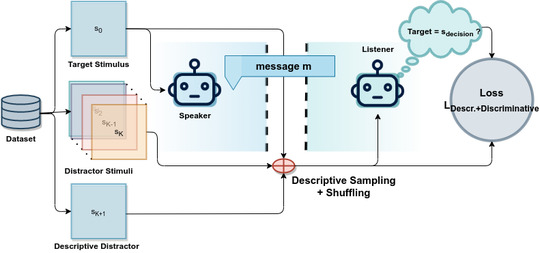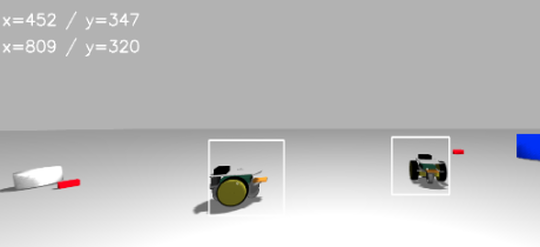Biography
Good morning (maybe?)! My name is Kevin Denamganaï, I am a PhD Student at the University of York, in the context of the IGGI program. I am advised by Dr James Alfred Walker and Dr Sondess Missaoui.
My main research is in Language Emergence and Grounding to support cooperation, aiming to understand how compositional communication emerges and whether it can be linked to systematicity/(algebraic) generalisation abilities, and be levered towards solving the agent alignment problem.
When I am stuck in this main research, I cope by letting my curiosity loose and so I am usually inquisitive about Unsupervised Representation Learning and Multi-Agent Deep Reinforcement Learning, trying to understand more about the emergence of (situated) cooperation.
Download my resumé.
- Unsupervised Representation Learning
- Language Grounding
- Language Emergence
- Deep Reinforcement Learning
- Basketball
- Kendo
- Meditation
- Astronomy
IGGI PhD Student, 2022
University of York
Master Recherche - Intelligence Artificielle et Robotique, 2017
Université de Cergy-Pontoise
Diplôme d'ingénieur - Informatique et Systèmes, 2017
Ecole National Supérieur de l'Électronique et de ses Applications
MEng in Electrical Engineering and Information Science, 2017
Osaka Prefecture University
Featured Publications

Natural language instruction following is paramount to enable collaboration between artificial agents and human beings. Natural language-conditioned reinforcement learning (RL) agents have shown how natural languages' properties, such as compositionality, can provide a strong inductive bias to learn complex policies. Previous architectures like HIGhER combine the benefit of language-conditioning with Hindsight Experience Replay (HER) to deal with sparse rewards environments. Yet, like HER, HIGhER relies on an oracle predicate function to provide a feedback signal highlighting which linguistic description is valid for which state. This reliance on an oracle limits its application. Additionally, HIGhER only leverages the linguistic information contained in successful RL trajectories, thus hurting its final performance and data-efficiency. Without early successful trajectories, HIGhER is no better than DQN upon which it is built. In this paper, we propose the Emergent Textual Hindsight Experience Replay (ETHER) agent, which builds on HIGhER and addresses both of its limitations by means of (i) a discriminative visual referential game, commonly studied in the subfield of Emergent Communication (EC), used here as an unsupervised auxiliary task and (ii) a semantic grounding scheme to align the emergent language with the natural language of the instruction-following benchmark. We show that the referential game’s agents make an artificial language emerge that is aligned with the natural-like language used to describe goals in the BabyAI benchmark and that it is expressive enough so as to also describe unsuccessful RL trajectories and thus provide feedback to the RL agent to leverage the linguistic, structured information contained in all trajectories. Our work shows that EC is a viable unsupervised auxiliary task for RL and provides missing pieces to make HER more widely applicable.
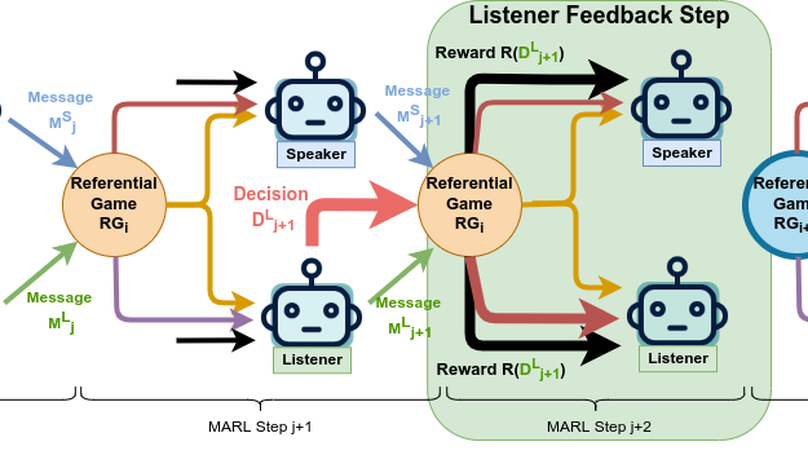
Human beings use compositionality to generalise from past experiences to novel experiences. We assume a separation of our experiences into fundamental atomic components that can be recombined in novel ways to support our ability to engage with novel experiences. We frame this as the ability to learn to generalise compositionally, and we will refer to behaviours making use of this ability as compositional learning behaviours (CLBs). A central problem to learning CLBs is the resolution of a binding problem (BP). While it is another feat of intelligence that human beings perform with ease, it is not the case for state-of-the-art artificial agents. Thus, in order to build artificial agents able to collaborate with human beings, we propose to develop a novel benchmark to investigate agents' abilities to exhibit CLBs by solving a domain-agnostic version of the BP. We take inspiration from the language emergence and grounding framework of referential games and propose a meta-learning extension of referential games, entitled Meta-Referential Games, and use this framework to build our benchmark, the Symbolic Behaviour Benchmark (S2B). We provide baseline results and error analysis showing that our benchmark is a compelling challenge that we hope will spur the research community towards developing more capable artificial agents.
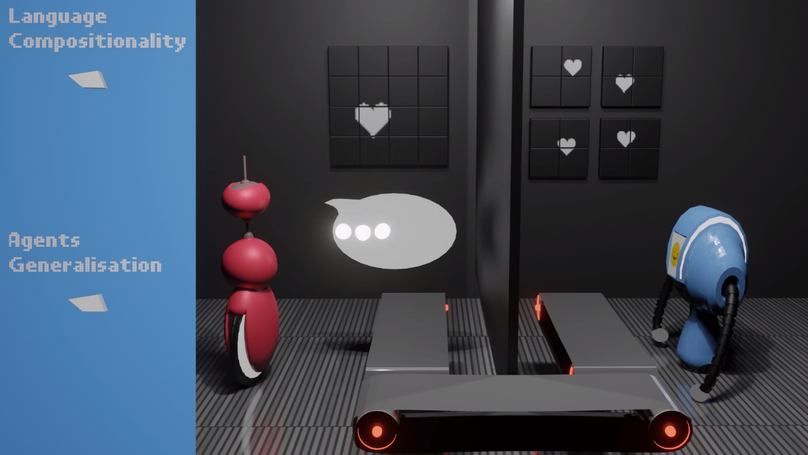
The drivers of compositionality in artificial languages that emerge when two (or more) agents play a non-visual referential game has been previously investigated using approaches based on the REINFORCE algorithm and the (Neural) Iterated Learning Model. Following the more recent introduction of the extit{Straight-Through Gumbel-Softmax} (ST-GS) approach, this paper investigates to what extent the drivers of compositionality identified so far in the field apply in the ST-GS context and to what extent do they translate into (emergent) systematic generalisation abilities, when playing a visual referential game. Compositionality and the generalisation abilities of the emergent languages are assessed using topographic similarity and zero-shot compositional tests. Firstly, we provide evidence that the test-train split strategy significantly impacts the zero-shot compositional tests when dealing with visual stimuli, whilst it does not when dealing with symbolic ones. Secondly, empirical evidence shows that using the ST-GS approach with small batch sizes and an overcomplete communication channel improves compositionality in the emerging languages. Nevertheless, while shown robust with symbolic stimuli, the effect of the batch size is not so clear-cut when dealing with visual stimuli. Our results also show that not all overcomplete communication channels are created equal. Indeed, while increasing the maximum sentence length is found to be beneficial to further both compositionality and generalisation abilities, increasing the vocabulary size is found detrimental. Finally, a lack of correlation between the language compositionality at training-time and the agents' generalisation abilities is observed in the context of discriminative referential games with visual stimuli. This is similar to previous observations in the field using the generative variant with symbolic stimuli.
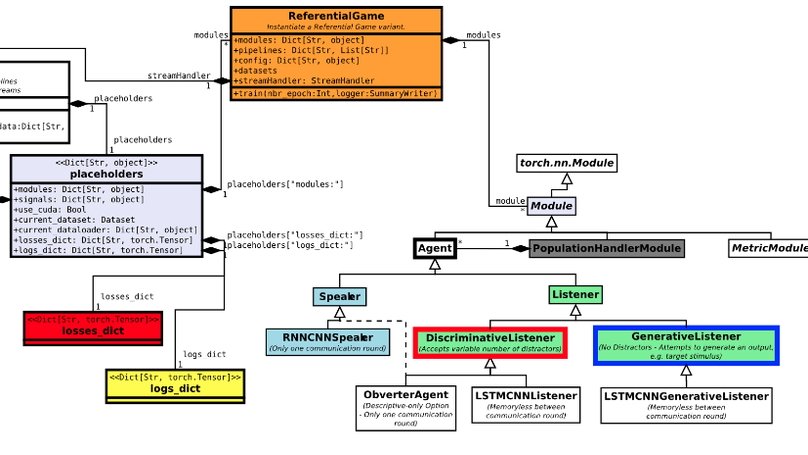
Natural languages are powerful tools wielded by human beings to communicate information and co-operate towards common goals. Their values lie in some main properties like compositionality, hierarchy and recurrent syntax, which computational linguists have been researching the emergence of in artificial languages induced by language games. Only relatively recently, the AI community has started to investigate language emergence and grounding working towards better human-machine interfaces. For instance, interactive/conversational AI assistants that are able to relate their vision to the ongoing conversation. This paper provides two contributions to this research field. Firstly, a nomenclature is proposed to understand the main initiatives in studying language emergence and grounding, accounting for the variations in assumptions and constraints. Secondly, a PyTorch based deep learning framework is introduced, entitled ReferentialGym, which is dedicated to furthering the exploration of language emergence and grounding. By providing baseline implementations of major algorithms and metrics, in addition to many different features and approaches, ReferentialGym attempts to ease the entry barrier to the field and provide the community with common implementations.

